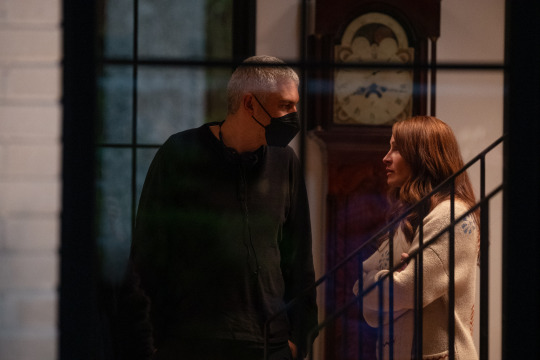#esmail corp
Photo

The Resort (prod. Andy Siara).
Starring Cristin Milioti and William Jackson Harper as a listless couple celebrating their wedding anniversary at a resort in the Mayan Riviera, the mystery comedy series flirts with greater philosophical ideas about fate and destiny as they and some of the local staff try to uncover the unsolved disappearance of two vacationing American teens fifteen years earlier.
There’s a deeper, more engaging and intriguing setup to the increasingly metaphysical story teasing sci-fi supernatural elements of a possibly interdimensional plain where you can seek enlightenment as the characters further explore possible spiritual lore behind the initial mystery they’re looking to solve.
#the resort#peacock#andy siara#reviews#cristin milioti#william jackson harper#ben sinclair#tv review#features#sam esmail#esmail corp#luis gerardo méndez#luis gerardo mendez#skyler gisondo#nina bloomgarden#gabriela cartol#nick offerman#tv#television#streaming#show#series#tv show#tv series#comedy#mystery#anonymous content#universal content productions#ucp
1 note
·
View note
Text
just finished watching Leave The World Behind and I have so many thoughts.
This is exactly what would happen, isn't it? We've seen it happen already with the pandemic and with what's happening in Gaza. This is how the western world, or at the very least the USA, reacts. It's always "us" versus "them". In this movie we've seen many instances of that division. The obvious one was racism. But there's also the class division. These families are here rather than in New York because of the amount of money they have. In the end, most of us will think of ourselves. If we do manage to think of others it'll most likely be whoever we see "as our own". It was Amanda being distrustful of the Scott family, it was Rose running off to watch Friends, it was Danny unwilling to help, it was Clay leaving the woman on the road behind. We think we're protecting our best interests as individuals, but within that mindset we tend to forget that sometimes that means seeking help and support from others. so much so that we reject others who do seek out help in times of crisis because those living in societies with predominantly individualistic norms and values simply don't know any better.
Besides that I also really like how this movie shows us our dependency on modern technology. The self driving teslas, the phones not working, no radio and no GPS. It's terrifying how easy the world, or at least the part of the world I'm at, would be completely and utterly fucked without modern tech. Makes me even more grateful for the paper maps I own and the cd's on my shelves lmao
Also. Sam Esmail's references to Mr. Robot? Absolutely incredible, loved it.
This movie was terrifying to me, but mostly because of how blind we were as an audience. The possibility of this becoming our reality, the fact that it IS the reality for those in palestine ... that's what really hit me
5 notes
·
View notes
Text


Image: IMDb

Photo: Netflix
In this apocalyptic thriller from award-winning writer and director Esmail (Mr. Robot), Amanda (Academy Award winner Roberts) and her husband Clay (Academy Award nominee Hawke), rent a luxurious home for the weekend with their kids, Archie (Charlie Evans) and Rose (Farrah Mackenzie). Their vacation is soon upended when two strangers — G.H. (Academy Award winner Ali) and his daughter Ruth (Myha’la Herrold) — arrive in the night, bearing news of a mysterious cyberattack and seeking refuge in the house they claim is theirs. The two families reckon with a looming disaster that grows more terrifying by the minute, forcing everyone to come to terms with their places in a collapsing world. Based on the National Book Award-nominated novel by Alam, Leave the World Behind is produced by Esmail Corp, Red Om Films, and executive produced by Higher Ground Productions. — Netflix
youtube



Remember when Tait joined Caitríona’s Amateur co-star at the UK Special Screening of her Money Monster co-star’s new film?
Even the Daily Mail was happy to see Tait. 😂
#Tait rhymes with hat#Good times#Leave The World Behind#UK Special Screening#The Curzon Mayfair#After Party#Kettners#29 November 2023#London#YouTube#The Daily Mail#Thanks p-redux#Thanks sunsetmagic85#Thanks castlemaine123#Thanks thetruthwilloutsworld
54 notes
·
View notes
Text
Since the conflict between Israel and Hamas broke out on Oct. 7, there has been concern that the regime in Iran might initiate a multiple front attack against Israel via its network of militias in the region—a threat that it has consistently made. Until now, much of the attention has focused on the Lebanon-based Hezbollah, the Islamic Revolutionary Guard Corps’ (IRGC) oldest and deadliest proxy. Yet there is another dimension to Tehran’s arsenal that has garnered less attention: the myriad militia groups it controls in Syria and Iraq.
Following the Oct. 7 attack, Esmail Qaani, the IRGC Quds Force commander responsible for managing the Iranian regime’s militia network, has made multiple trips to Syria to coordinate with the IRGC’s proxies there and in neighboring Iraq. Qaani’s visits have been followed by more than 40 missile or drone strikes by Tehran’s proxies against U.S. forces in Syria and Iraq, with the objective of both testing U.S. redlines and controlling the path of escalation. These attacks have been coupled with multiple reports indicating that the IRGC’s proxies in Syria have begun mobilizing toward the Israeli border. Syrian media has also indicated that Hezbollah’s elite Radwan Unit had arrived in Syria in October and deployed close to Israel.
But perhaps the clearest indication about the integral role of the Syrian front to the IRGC’s multifront escalation against Israel came just a few days ago, on Oct. 22, when Qaani reportedly visited southern Syria and established a new “joint operation room” for the IRGC and its proxies alongside the Golan Heights.
The Iranians will likely carefully calibrate their use of proxies and partners with the progress that Israel makes in its campaign to destroy Hamas in the Gaza Strip. As Israel advances, the intensity of the response by the IRGC’s so-called axis of resistance will increase. This will be especially true if Hamas appears on the verge of being defeated in Gaza. Militias in Iraq and Syria will figure heavily in this response.
Tehran sees the Hamas attacks on Israel as the beginning of a longer confrontation with the latter. In essence, the doctrine that the IRGC has built around this long war seeks to make Israel bleed slowly over a long period of time. As senior IRGC commanders have asserted, “the Palestinian operation is the beginning of the Resistance Axis’ movement to destroy Israel.”
In other words, even when this Hamas-Israel conflict eventually settles down, Tehran is preparing for more escalations, albeit from different fronts—and this is where Syria becomes particularly important.
While Tehran commands multiple militia assets across Syria, there are two particularly heavily armed and indoctrinated IRGC-manufactured proxies that have, since their inception, been specifically designed to target Israel: the IRGC’s Shiite Afghan Fatemiyoun and Pakistani Shiite Zainabiyoun militias.
To understand the nature, purpose, and capabilities of these two understudied and overlooked groups, it is essential to go back to their formation during the Syrian civil war.
The outbreak of the Syrian protests in 2011-12 against the Bashar al-Assad regime would prove to be the most consequential phase in the development of the IRGC’s militia doctrine. Syria had been the backbone of Tehran’s so-called axis of resistance, the main artery of support for Hezbollah, and was critical to the existence of the IRGC’s regional expansionist militancy project. Facing the likely prospect of the fall of the Assad regime, from 2013 onward, the IRGC was be forced to change track in Syria.
The first step toward achieving this would come when Ayatollah Ali Khamenei, the Iran’s supreme leader, would transform the IRGC’s involvement in Syria from preserving Assad to carrying out a Shiite jihad and “defending the holy Shia shrines” that he said were under attack by a “[Gulf] Arab-Zionist-Western” axis.
This call for a Shiite jihad, which was ignored in the West, would enable the regime in Iran to introduce an ideological element to the conflict, centered on extreme antisemitism and sectarianism, to draw on the regime’s ideological influence across the region. For Khamenei and senior IRGC commanders, such as Hossein Hamedani, the poor performance of the Syrian military and other pro-Assad groups was due to their lack of ideological commitment as a fighting force. These groups were viewed as mercenaries that lacked the necessary ideological devotion.
The call for a Shiite jihad was the pretext for the IRGC to construct ideologically compliant militias from scratch. On the spectrum of the IRGC’s proxy assets, IRGC-manufactured militias are the most deadly and are under its full command and control. These groups not only receive military, financial, and logistical support from Tehran, but the IRGC also spends significant time and resources to radicalize all of its recruits to ensure that they are ideologically driven militants rather than simply being paid mercenaries.
To operationalize this new plan, the IRGC made full use of the Iranian regime’s soft-power infrastructure across the Middle East and beyond to recruit and radicalize young Shiite men to manufacture new militia groups. Senior IRGC commanders directly tied to Khamenei’s office—such as Saeed Ghasemi—led these efforts.
Ghasemi, who had played a key role in official IRGC recruitment and indoctrination programs, immediately set his eyes on Iran’s significant Afghan Shiite refugee population, having long spoken of a desire to establish a Hezbollah of Afghanistan. Soon, thousands of Afghan and Pakistani Shiite students studying at the IRGC-affiliated Al-Mustafa International University were being targeted for recruitment.
These students were used to form two IRGC cells in 2014-15: the Afghan Fatemiyoun cell, made up of around 1,000 militants, and the smaller Zainabiyoun cell, initially made up of no more than 24 militants. Yet Western policy toward Iran during this time inadvertently freed up resources that enabled the IRGC to upgrade them to full militias, both in terms of capabilities and size. With the lifting of some international sanctions on Tehran as part of the interim nuclear deal in 2013 and later the 2015 Joint Comprehensive Plan of Action (JCPOA), the IRGC had the funds to grow these proxies and rapidly increase the number of IRGC-manufactured militias beyond these two groups.
In just a couple of years, the Fatemiyoun had increased its fighting force to more 15,000 militants and the Zainabiyoun to approximately 5,000 fighters.
Tehran spent significant time and resources on radicalizing these militants, mimicking the IRGC program of indoctrination that makes up more than 50 percent of the training for its own members. It is the tailor-made Islamist extremist views with which these Afghan and Pakistani recruits were trained that make them specifically designed to target Israel. These recruits have been indoctrinated under the IRGC’s militaristic doctrine of Mahdism, which claims that the biggest barrier to the return of Shiite Islam’s messianic Hidden Imam (Imam Mahdi) is the existence of the state of Israel.
Prior to the Mahdi’s arrival—according to some historic Shiite narrations—there will be an apocalyptic war that will destroy Israel and Jews worldwide. As part of the IRGC’s indoctrination program, militants are radicalized to believe that the IRGC and its proxy fighters are the military vehicle to speed up and prepare the foundations for the Mahdi’s return. As one IRGC cleric responsible for ideological activities of the Fatemiyoun asserted: “the Fatemiyoun is an example of the movement to prepare the foundations for [the Hidden Imam’s] reappearance.”
This doctrine was at the forefront of the IRGC’s efforts to recruit, radicalize, and train members of the Fatemiyoun and Zainabiyoun, with the fight in Syria described as the prelude to a final battle to eradicate Israel. As the Farsi memoirs written by a late Fatemiyoun commander in 2015 state: “The wish of our Fatemiyoun is face-to-face confrontation with the usurping Israeli regime. The Fatemiyoun is training in Syria, and then we will fulfill the divine promise of [former Iranian Supreme Leader Ruhollah] Khomeini. Israel must be wiped from the face of the Earth.” Multiple firsthand accounts by Fatemiyoun recruits echo the same message: The so-called “final battle” against Israel is what motivates them.
In many ways, the IRGC stayed true to its words and mission. Having used these proxy groups to brutally suppress the Syrian revolution, it did not take long for the IRGC to establish military positions alongside the border with Israel to open a new front—all of which took place right under the West’s nose.
Israel has, of course, been well aware of this threat, which is why it has undertaken an aggressive air campaign targeting those assets. Yet these strikes have failed to deter the IRGC.
Since then, Khamenei’s regime in Iran has been focused on consolidating the IRGC’s positions in Syria and expanding the fighting forces of the Fatemiyoun and Zainabiyoun proxies. The U.S. withdrawal from Afghanistan and the Taliban’s takeover of Kabul, which resulted in a mass exodus of Shiite Afghan refugees to Iran, has provided the IRGC with the perfect storm to exploit and beef up the number of Fatemiyoun recruits.
Militants from these proxy groups have also started playing a more active role in IRGC-Quds Force terrorist operations abroad, which have targeted Israeli citizens and members of the Jewish community. In October 2021, counterterrorism police in Cyprus foiled an IRGC-linked terrorist plot against an Israeli citizen, which was orchestrated by a Pakistani cell affiliated with the Zainabiyoun. Israel has also downed drones that it concluded had been launched by the IRGC from Syria.
Iraq is another theater that the Iranian regime can draw from instead of using Hezbollah to fully open a northern front against Israel. Like Syria, the U.S. military has also downed drones over Iraq that were set to attack Israel, including two that were shot down in early 2022.
Already, there have been reports that militiamen from Iraq have arrived in Lebanon. This dynamic displays the flexibility and portability of some elements of the Iranian regime’s axis of resistance. With Hezbollah playing a larger role in managing that axis in the aftermath of the death of the late Quds Force Commander Qassem Suleimani, this can be a way for its Secretary-General Hassan Nasrallah to reduce the burden on Hezbollah of responding and instead diffuse responsibility to other elements of the axis of resistance.
For both the IRGC and Hezbollah, an attack against Israel from the Syrian or Iraqi fronts might be preferable right now given that any Hezbollah intervention would risk the group’s standing domestically in Lebanon. Stationed in Assad’s Syria, neither the Fatemiyoun nor the Zainabiyoun come with the same domestic baggage, making their intervention much lower in risk for Tehran. Ditto for the Iraqi militias, although they are less expendable than their Syrian counterparts given the sensitive political situation in Iraq, with Washington having more leverage over Baghdad than Damascus.
From a military standpoint, there is also much less to lose than intervention from southern Lebanon. Hezbollah remains the IRGC’s most valuable asset in the region, and it has armed the group with a highly sophisticated infrastructure of weapons. The IRGC would find it much easier to digest using Fatemiyoun and Zainabiyoun militants as cannon fodder than risk harming its gold standard terror group in Lebanon.
The journey through which the IRGC has taken militias such as the Fatemiyoun and Zainabiyoun has mimicked that of Hezbollah in Lebanon. The IRGC has been able to manufacture two highly armed and indoctrinated Islamist terrorist organizations made up of deeply antisemitic militants motivated by the goal of eradicating the world’s only Jewish-majority country—and station them mere kilometers away from Israel’s border.
It is precisely for this reason that the Syrian and Iraqi fronts should not be overlooked in assessments on the threat of the multifront attack on Israel. Since Oct. 7, the IRGC has doubled down on its Mahdist doctrine messaging to communicate the terrorist attacks on Israel as the prelude to its destruction and return of the Hidden Imam. This should set off alarm bells. Governments and policymakers have consistently overlooked and underestimated the ideological aspect to the IRGC and its proxy network. This has in part been ignored because of its complexity, in part because it did not suit the policy agenda.
However, especially as Fatemiyoun and Zainabiyoun militants mobilize toward the Israeli border against the beat of the IRGC’s Mahdist drum, it would be a fatal error to underestimate this threat from Syria and beyond. The IRGC recruited, radicalized, and designed these militias with the stated objective of fighting Israel. What might have seemed like mere propaganda almost a decade ago is perhaps much closer to reality today.
5 notes
·
View notes
Text
0 notes
Text
Zac Efron Set for Dual Roles in Celebrity Doppelgänger Thriller 'Famous' for Black Bear and Esmail Corp.

View On WordPress
0 notes
Text
Cuando el caos se apodera de la humanidad, la confianza se desvanece con rapidez… “Dejar El Mundo Atrás”

En este thriller apocalíptico, Amanda y su esposo Clay alquilan una lujosa propiedad para pasar un fin de semana tranquilo con sus hijos, Archie y Rose. Pero la escapada familiar se ve interrumpida cuando dos desconocidos, que se presentan como G. H. y su hija Ruth, llegan en medio de la noche, alertan sobre un misterioso ciberataque y pretenden refugiarse allí, porque dicen que esa es su casa.
Ambas familias deben lidiar con la inminente crisis a su manera, mientras luchan por encontrar un lugar en un mundo que se derrumba.
Estreno: 8 de diciembre de 2023 en Netflix.
youtube
Basada en la novela homónima de Rumaan Alam, la película está producida por Esmail Corp y Red Om Films, dirigida por Sam Esmail y protagonizada por Julia Roberts, Ethan Hawke, Farrah Mackenzie, Charlie Evans, Myha'la Herrold, Mahershala Ali y Kevin Bacon.







Detrás De Cámaras


Pósteres Individuales




El elenco atendiendo la proyección especial en Nueva York el 4 de diciembre de 2023


#Leave the World Behind#Julia Roberts#Ethan Hawke#Farrah Mackenzie#Charlie Evans#Myha'la Herrold#Mahershala Ali#Kevin Bacon#Películas#Netflix
0 notes
Text
Iranian Horn Tells Iraqi Horn to Leave Babylon the Great Alone: Daniel
Iran Tells Iraqi Proxy to Leave U.S. Alone
BY MIHAILO S. ZEKIC • AUGUST 17, 2023
Iran is about to go easy on American targets in Iraq, according to Qatari news medium Al Araby, yesterday. A member of the Iran-backed Shia Coordination Framework claims that Iran’s Islamic Revolutionary Guard Corps (irgc) is pressuring its Iraqi partners to leave American targets alone.
Esmail Qaani, leader of…

View On WordPress
0 notes
Text
0 notes
Text
5 Mind-Blowing Plot Twists in Mr. Robot You Didn't See Coming
Mr. Robot is a critically acclaimed television series that has captivated audiences with its complex characters and intricate plot. With each season, the show has delivered shocking twists and turns. These have left viewers on the edge of their seats. Here are 5 of the most jaw-dropping plot twists from the series.
5. Elliot’s alter-ego, Mr. Robot, is actually his father
© Esmail Corp (Mr.…

View On WordPress
0 notes
Text
'Leave the World Behind' Julia Roberts Movie: Coming to Netflix in December 2023
Leave the World Behind – Picture. Esmail Corp.
Oscar-winning performers Julia Roberts and Mahershala Ali star in the adaptation of the acclaimed Rumann Alam novel, Leave the World Behind. Scheduled to arrive in late 2023, there’s already something to look forward to on Netflix for the Holiday season.
The film is conceived by Mr. Robot creator Sam Esmail. Esmail has written the screenplay and…

View On WordPress
0 notes
Text
When the agreement between Saudi Arabia and Iran to resume diplomatic relations was announced on March 10, many U.S. officials and commentators welcomed it. Even though the Chinese-sponsored deal was an apparent blow to the United States’ status in the Middle East, experts speculated that normalization between the Saudis in Riyadh and the Iranians in Tehran would lead to regional de-escalation.
The well-respected Economist Intelligence Unit best summed up this view, declaring, “Greater dialogue and co-operation between Saudi Arabia and Iran rather than antagonism and active support for rival factions would remove an important destabilising dynamic from the region’s conflict zones”—though the unnamed authors acknowledged that violence remained possible. Others suggested that the agreement could provide a range of benefits beyond the conflict zones, including an end to Iran’s meddling in Bahrain, renewed Saudi investment in Iran, and even improved chances for nuclear nonproliferation.
Greater dialogue and cooperation between the Saudis and Iranians is positive, of course. Yet despite the planned exchange of ambassadors and an invitation from Saudi King Salman to Iranian President Ebrahim Raisi to visit Saudi Arabia, de-escalation has not happened. A tour around the region, from Syria to Israel’s borders to the Strait of Hormuz, indicates the opposite. It is early, of course. The Beijing-brokered agreement is only three months old. But so far, it looks like the Iranians are leveraging normalization to press their regional advantage rather than diminish tensions.
The greatest promise of the Iran-Saudi Arabia normalization is peace in Yemen. The Saudis want to end their military intervention there and have sought help from Tehran, which has become a patron of Riyadh’s antagonists, the Houthis. But so far, normalization has not had a dramatic impact on the situation on the ground.
There is a cease-fire, ships can offload aid and goods at ports that were previously blocked, and the airport in the Yemeni capital, Sana’a, is open. That is all good news, but these developments predate the Saudi-Iranian-Chinese agreement. There are peace talks, but an end to the conflict in Yemen remains elusive largely because the Houthis have been intransigent. Perhaps that will change, and perhaps it will be the result of the new dialogue between the Saudi and Iranian governments, but so far it is hard to argue that Yemen’s trajectory has improved markedly as a result of the agreement.
The situation elsewhere in the Middle East hardly seems better. Just three weeks after the Saudis and Iranians came to terms, Iranian proxies attacked U.S. forces in Syria, killing a U.S. contractor and injuring several U.S. soldiers. Iran’s agents routinely target the roughly 900 U.S. troops (and an undisclosed number of U.S. contractors) in Syria, but the resumption of ties between Saudi Arabia and Iran was supposed to have salutary effects on tensions across the Middle East.
One can debate why the United States is in Syria, but if Tehran were interested in regional de-escalation, its allies would likely hold their fire. Instead, Iran remains committed to pushing the United States out of the Middle East; and clearly, it wants to put Americans under fire to accomplish that goal.
Not long after U.S. soldiers fended off drone strikes in Syria, Esmail Qaani, the commander of Iran’s Islamic Revolutionary Guard Corps’ Quds Force, held a meeting with leaders of Hamas, Hezbollah, and Palestinian Islamic Jihad (PIJ) in Beirut. The result was coordinated rocket attacks on Israel from Lebanon, Syria, and the Gaza Strip. About a month later, in Syria’s capital, Damascus, Raisi met with Palestinian militant group leaders who reportedly expressed gratitude for Tehran’s support.
Iran’s goal seems to be an escalation of its shadow war with Israel. So far, the Israelis have had the clear advantage, routinely hitting Iranian and Iranian-aligned groups in Syria and Iraq. Until now, Iran has been unable to respond effectively on the battlefield; but Qaani evidently believes that if he can unite Iran’s proxies, he can reverse Iran’s fortunes. It may not work out that way for the Quds Force commander, however. The Israelis killed several PIJ commanders in fighting in early May as Hamas watched from the sidelines. There is no indication that this setback has caused Qaani to rethink his effort to escalate the conflict with Israel, though.
Then there are the waters of the Persian Gulf. In May, the Pentagon announced it was bolstering its “defensive posture” in the area. Why? Because the Iranians were, once again, threatening the sea lanes. After Qaani’s Beirut confab, the United States picked up information that Tehran was planning to attack commercial vessels in Middle Eastern waters.
In the span of just a week in late April and early May, Iranian forces seized two oil tankers; according to U.S. officials, Iran has harassed, attacked, or interfered with 15 internationally flagged commercial ships over the past two years. Tehran seems to be responding to U.S. sanctions enforcement, calculating that shipping—any shipping—in the Gulf is fair game. One of the tankers it took was steaming between Emirati ports in Dubai and Fujairah, even as the United Arab Emirates has normalized ties with Iran. That does not seem like de-escalation, does it?
The big story about the Iran-Saudi-China deal is not the development of a more stable, pacific Middle East in which regional actors take matters into their own hands to forge a better future. It is actually more straightforward than that: The Saudis lost, and normalization of diplomatic relations with Iran is just cover for that setback.
In a variety of ways, the Saudis seem ascendant: essentially buying the U.S. PGA Tour; pursuing policies independent of their patron, the United States; and investing everywhere from Beijing to the San Francisco Bay Area. But in the Middle East—specifically Yemen, Lebanon, Syria, and Iraq—the Saudis has been unable to dislodge the Iranians, who have either reinforced or extended their influence in all four countries in recent years. Perhaps the most dramatic manifestation of this was Saudi Arabia’s willingness to bring Syrian President Bashar al-Assad—who owes his continued rule in part to Iran—back into the Arab League’s good graces.
The Saudis may be masters of international golfing, but the Iranians have won where it counts. Now, having taken Riyadh off the table, Tehran is working to undermine what is left of the region’s anti-Iran regional coalition—a policy that includes going on the offensive against Israel and the United States.
For too long, bad assumptions have formed the basis of U.S. Middle East policy, including the notion that Iran’s leaders want to normalize ties with their neighbors. In reality, Iran does not want to share the region and is not a status quo power. The regime’s goal is to reorder the region in a way that favors Tehran, and with the Saudis now promising an ambassador and investment, the Iranians have determined they are now freer to advance their agenda. In other words, no de-escalation.
6 notes
·
View notes
Text
Inmr review

#Inmr review series
#Inmr review mac
Bobby Cannavale as Irving, a used car salesman who is a Dark Army fixer (season 3 guest season 4).A younger Whiterose was portrayed by Ross Kurt Le (season 4). Whiterose also operates as Zhi Zhang, China's Minister of State Security (seasons 3–4 recurring seasons 1–2). BD Wong as Whiterose, a trans woman, cyber-terrorist and head of the Dark Army.Grace Gummer as Dominique "Dom" DiPierro, an FBI field agent investigating the E Corp hack (seasons 2–4).Stephanie Corneliussen as Joanna Wellick, Tyrell's wife (seasons 2–3 recurring season 1).Michael Cristofer as Phillip Price, the CEO of E Corp (seasons 2–4 recurring season 1).Robot, an insurrectionary anarchist who recruits Elliot into an underground hacker group called fsociety and Edward Alderson, Elliot's father. Martin Wallström as Tyrell Wellick, originally the ambitious Senior Vice President of Technology at E Corp and later part of fsociety.Portia Doubleday as Angela Moss, Elliot's childhood friend and a fellow employee at Allsafe, later PR Manager for E Corp.Carly Chaikin as Darlene Alderson, Elliot's younger sister, a malware coder and one of the fsociety hackers.Elliot is portrayed as a child by Aidan Liebman (seasons 1–2), Alex Bento (season 3), and Evan Whitten (season 4). Elliot's hacker nickname is "Sam Sepiol" or "samsep10l". He has dissociative identity disorder and deals with other mental illnesses such as clinical depression and severe anxiety, which are partly responsible for his antisocial behavior and drug use. Rami Malek as Elliot Alderson, a senior cybersecurity engineer at Allsafe Cybersecurity and a vigilante hacker.One of their missions is to cancel all consumer debt by encrypting all the data of one of the largest corporations in the world, E Corp (which Elliot perceives as Evil Corp), which also happens to be Allsafe's biggest client. Robot and joins his team of hacktivists known as fsociety. He is recruited by a mysterious insurrectionary anarchist known as Mr. He connects to people by hacking them, which often leads him to act as a cyber- vigilante. Constantly struggling with social anxiety, dissociative identity disorder, clinical depression and drug abuse, Elliot's thought process seems heavily influenced by paranoia and delusion.
#Inmr review series
The series follows Elliot Alderson, a young man living in New York City, who works at the cybersecurity company Allsafe as a cybersecurity engineer. The show received numerous accolades, including two Golden Globe Awards, three Primetime Emmy Awards, and a Peabody Award.įurther information: List of Mr. Esmail has received praise for his direction of the series, having directed three episodes in the first season before serving as the sole director for the remainder of the show.
#Inmr review mac
Robot has received critical acclaim, particularly for the performances of Malek and Slater, its story and visual presentation, and Mac Quayle's musical score. The fourth and final season premiered on October 6, 2019, and concluded on December 22, 2019. The first season debuted on USA Network on June 24, 2015, while the second season premiered on July 13, 2016, and the third season premiered on October 11, 2017. The series stars an ensemble cast featuring Rami Malek, Carly Chaikin, Portia Doubleday, Martin Wallström, Christian Slater, Michael Cristofer, Stephanie Corneliussen, Grace Gummer, BD Wong, Bobby Cannavale, Ashlie Atkinson, and Elliot Villar. The pilot premiered via online and video on demand services on May 27, 2015. The group aims to destroy all debt records by encrypting the financial data of E Corp, the largest conglomerate in the world. Robot", played by Christian Slater, to join a group of hacktivists called "fsociety". Elliot is recruited by an insurrectionary anarchist known as "Mr. It stars Rami Malek as Elliot Alderson, a cybersecurity engineer and hacker with social anxiety disorder and clinical depression. Robot is an American drama thriller television series created by Sam Esmail for USA Network.

0 notes
Photo







Esmail Corp, iHeart Radio, Radiodotcom, World Music Awards, iHeart Radio Canada, Wild 95.5, Sony - 20.05
#20052#louis tomlinson#iheart radio#iheart radio canada#radiodotcom#esmail corp#world music awards#press#ltour#wild 955
260 notes
·
View notes
Text










Rami birthday picstravaganza! Happy birthday to our tiny little ball of sunshine! 😍🥰🥳 (📷: 1: Esmail Corp, 2: official James Bond, 3: Stephanie Corneliussen, 4-8: Gwilym Lee, 9-10: Joe Mazzello)
#rami malek#ramimalek#rami#happy birthday rami#happy birthday#mr robot#elliot alderson#esmail corp#stephanie corneliussen#james bond#no time to die#safin#bohemian rhapsody#borhap#gwilym lee#joe mazzello#ben hardy#cardboard ben#lucy boynton#allen leech#freddie mercury#queen
44 notes
·
View notes
Text
Hamas chief praises Iran’s support outside the Temple Walls: Revelation 11
Hamas chief praises Iran’s support for Palestine
May 23, 2023
Haniyeh made the remarks in a message addressed to Commander of the Quds Force of Iran’s Islamic Revolution Guards Corps (IRGC), Brigadier General Esmail Qaani, on Monday.
He said Iran is “a solid pillar upon which Palestinian resistance groups, and the Axis of Resistance in general, rest as they continue their primary struggle…

View On WordPress
0 notes